Univ. of Puerto Rico Sea Grant College Interim Progress Report (09/30/17)
Interim Research Progress Report
University of Puerto Rico Sea Grant College
Reporting Period: 2/01/17-7/31/17
Assessment of the Impact of Watershed Development and Restoration on Marine Sediment Dynamics, St. John, USVI
Sarah C. Gray (Dept. of Environmental and Ocean Sciences, University of San Diego); Carlos E. Ramos-Scharrón (Dept. of Geography, University of Texas, Austin); Gregg R. Brooks (Dept. of Marine Science, Eckerd College)
-Results and findings
Terrestrial monitoring. Rainfall total for Jan-17 through Apr-17 was 171 mm or 69% of normal and it was distributed over 91 events (Fig. 1). At Shipwreck Ghut, only nine of those events generated runoff for a total of 9.9 mm or 5.7 % of rainfall. Only one event triggered a total of 0.002 mm of runoff at Johnny Horn Ghut and this is only 0.001% of rainfall. Rain-runoff analyses for data spanning back to Nov-13 (Shipwreck) and Aug-14 (Johnny Horn) showed that runoff occurs about twice more frequently at Shipwreck and that it produces roughly 7.2 times more runoff than at Johnny Horn. Johnny Horn is operating almost like an undisturbed site although it contains a number of roads, but Shipwreck’s response is anomalous and is due to a high density of roads.
Marine Monitoring. Greater terrigenous sediment accumulation was measured below developed compared to minimally developed watersheds in sediment traps (Fig. 2A) Though statistically significant decreases in sedimentation rates were not detected post restoration due to f resuspension, we observed significant decreases (17-41% decrease) in trap and benthic % clay and %terrigenous sediment post-restoration at all developed shore sites (Fig. 2B). Since there were no significant differences in % clay post-restoration at minimally developed sites in either the trap or the benthic samples we may conclude that this decrease could be an outcome of restoration. Both near shore patch reefs and coral reefs below the developed watersheds were under stress from terrigenous and finegrained sedimentation for over half of the sampling periods (Fig. 2C). Nephelometer turbidity and deposition values averaged over ~26-day sediment trap deployment periods were significantly correlated with sediment trap accumulation rates at most sites.
Short-lived radioisotope (SLR) analyses. Activities of 7Be (t1/2=53 days) were present in almost all sediment trap and adjacent bottom samples (Fig. 3), (though higher in the traps than the benthic samples) suggesting active deposition of island-derived sediment within the past year. This indicates that some terrigenous sediment is rapidly transported to the reefs and the outer part of Coral Harbor and beyond (Fig. 5) Monthly time series data show similar temporal patterns in 7Be activities. 7Be activities decreased from August through October, and then increased in November. During the next reporting period these data will be integrated with rainfall and runoff data to further determine linkages among rainfall, runoff, sediment distribution patterns and island-derived sediment residence times within the Coral Bay basin.
Univ. of Puerto Rico Sea Grant College Interim Progress Report (09/30/17)
-Methods used
Terrestrial monitoring (Fig. 1). Continuous rainfall intensity was measured from one of the four rain gauges located within the Coral Bay Watershed. Data from other three stations is being managed by the Coral Bay Community Council and is sporadic and of questionable quality. To interpret stream discharge, water stage levels were measured with pressure transducers at 10 min intervals. Suspended sediment samples were manually collected during several run off triggering events and sent for suspended sediment concentration and isotopic analyses.
Marine Monitoring (Fig. 2). From July-Nov. 2016, sediments were collected from 7 sedimenttraps over 5 monthly sediment collection periods. Four nephelometers and Marotte current meters were deployed which measured turbidity and deposition at 10 minute intervals. Sediment accumulation rates, composition (% terrigenous, organic and carbonate) and sediment texture (grain size distribution) were determined by Loss on Ignition (LOI) and a Laser Particle Sorter.
SLR analyses. Sediment samples were analyzed by gamma spectrometry on Series HPGe Coaxial Planar Photon Detectors for multiple radioisotopes (210Pb 214Pb 214Bi 137Cs 7Be) activities.
-Objectives (% completed)
• To extend our program of joint terrestrial-marine monitoring for five months during the rainy season (Jul.-Nov.) 2016. (100%)
• To conduct hydrologic monitoring of rainfall intensity and streamflow in three ephemeral drainages (“ghuts”) (100%)
• To constrain runoff thresholds (40%)
• To develop detailed geospatial databases which will aid in describing the degree of surface runoff and sediment connectivity between landscape units and the watershed outlet. (25%)
• To extend marine sediment trap and nephelometer monitoring over an additional “postrestoration” rainy season (100%)
• To determine if there has been a measurable reduction in terrigenous sedimentation postrestoration at sites below ARRA restoration projects (100%)
• To link watershed (runoff) and oceanographic processes to marine sediment dynamics at high temporal resolution (minutes-hours) and assess how these processes vary spatially and temporally (0%)
• To compare different marine sedimentation monitoring approaches (30%)
• To collect samples for SLR analysis (100%)
• To constrain the ages and residence times of island-derived sediments collected in the sediment traps using short-lived radioisotopes (SLR). (70%)
-List PI’s supported
Univ. of Puerto Rico Sea Grant College Interim Progress Report (09/30/17)
Ramos-Scharrón received a one-half month and Gray received 0.4 compensation from Sea Grant during this reporting period.
-List students supported. No students were supported by Sea Grant funds during the reporting period. However, one graduate student (USD) and two undergraduate students (Eckerd College) were involved in the project.
MS (USD) Stephen Campbell (stephencampbell@sandiego.edu)
BS (Eckerd) Jacob Fillingham (jnfillin@eckerd.edu)
BS (Eckerd) Savannah Carter (srcarter@eckerd.edu)
-Impact/Accomplishment
1. RECAP. A multi-year terrestrial-marine monitoring program in Coral Bay, St. John, USVI to test the effectiveness of watershed restoration completed in 2011 was extended and expanded to measure: (a) terrestrial erosion and runoff-sediment yields; (b) time integrated (sediment traps) and high resolution (nephelometers) marine terrigenous sedimentation and turbidity at shoreline and coral reef sites; and (c) sediment “residence time” using short-lived radioisotopes (SLR).
2. RELEVANCE Terrigenous sediment derived from unpaved roads is a significant stressor to coral reefs in the US Virgin Islands. The 10.7 km2 Coral Bay watershed was the focus of a NOAA-ARRA watershed restoration program completed in 2011, which included: sediment retention structures, road drainage improvements and road paving. However, the effectiveness of this restoration has not been tested. This watershed restoration and monitoring program may serve as a case study on how to develop effective management and monitoring strategies that may be applied to other areas with similar ephemeral hydrologic behavior.
3. RESPONSE In 2016, a multi-year terrestrial-marine monitoring program was extended and expanded by the co-P.I.’s (S. Gray, Univ. of San Diego, C. Ramos-Scharron, Univ. of Texas, Austin, G. Brooks, Eckerd College) in partnership with local environmental managers (Coral Bay Community Council) to test the impact of watershed development and the effectiveness of watershed restoration on marine sedimentation on coral reefs
4. RESULTS. Spatially variable runoff response to rainfall in the restored watersheds were observed with some restored areas operating like undisturbed watersheds and others generating anomalously high runoff. Restoration appeared to have resulted in significant decreases (17-41%) in trap and benthic % clay and %terrigenous sediment in the marine environment. Activities of 7Be (t1/2=53 days) suggested active deposition of islandderived sediment within the past year and the rapid transport of land-derived sediment to the reefs Coral reefs below developed watersheds were under stress from terrigenous and fine-grained sedimentation for over half of the sampling periods.
Univ. of Puerto Rico Sea Grant College Interim Progress Report (09/30/17)
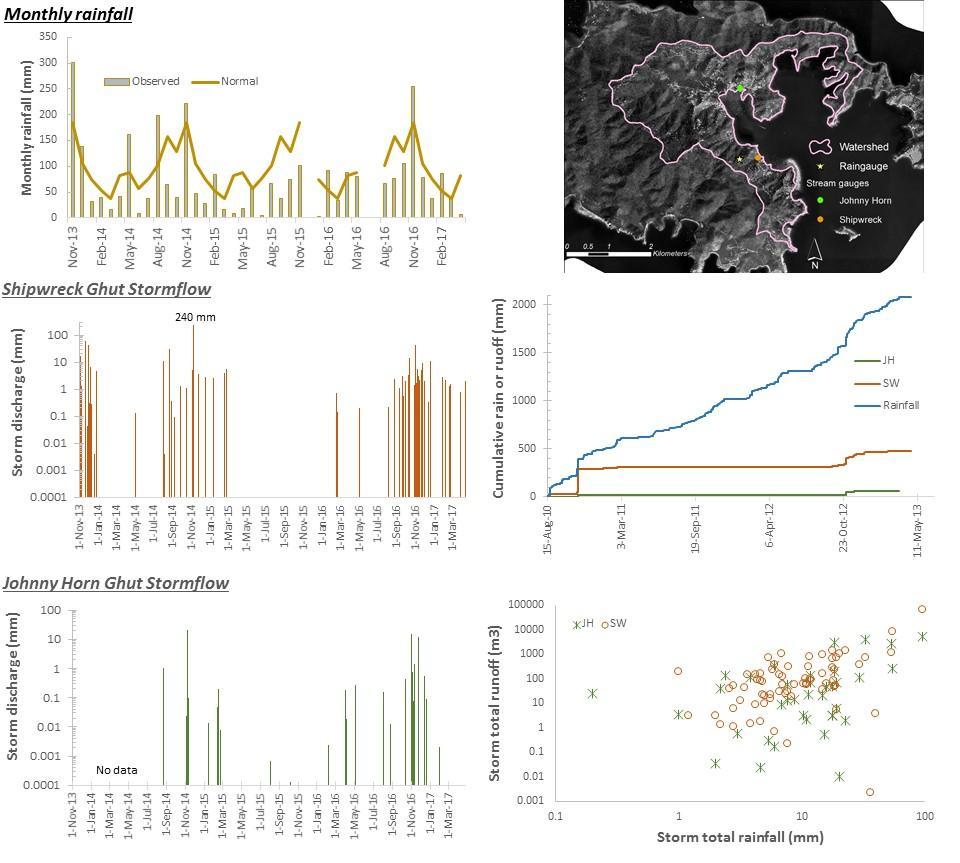
Univ. of Puerto Rico Sea Grant College Interim Progress Report (09/30/17)
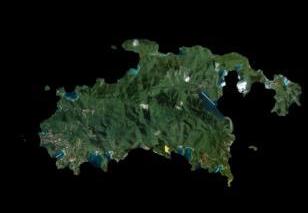






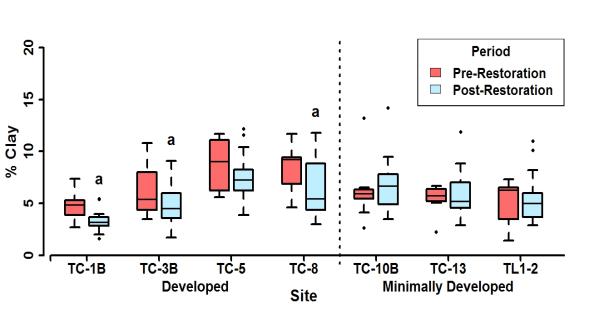
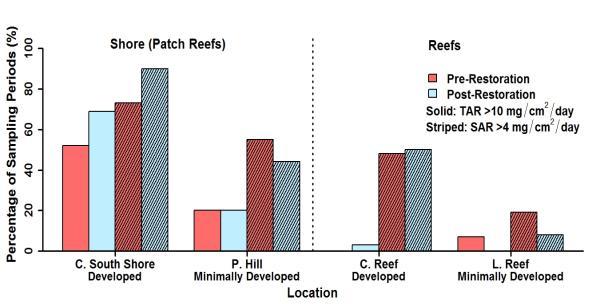
Figure 2 A. Map of Marine sampling sites showing developed (brown shading) and minimally developed (green shading) watersheds. B. Percentage of clay in trap samples pre- vs. post-restoration at shore sites during fall sampling periods. "a" indicates significant difference between pre- and post- restoration. C. Percentage of sampling periods in which corals are under stress from terrigenous sediment or siltation stress according to published stress “thresholds”.
Univ. of Puerto Rico Sea Grant College Interim Progress Report (09/30/17)
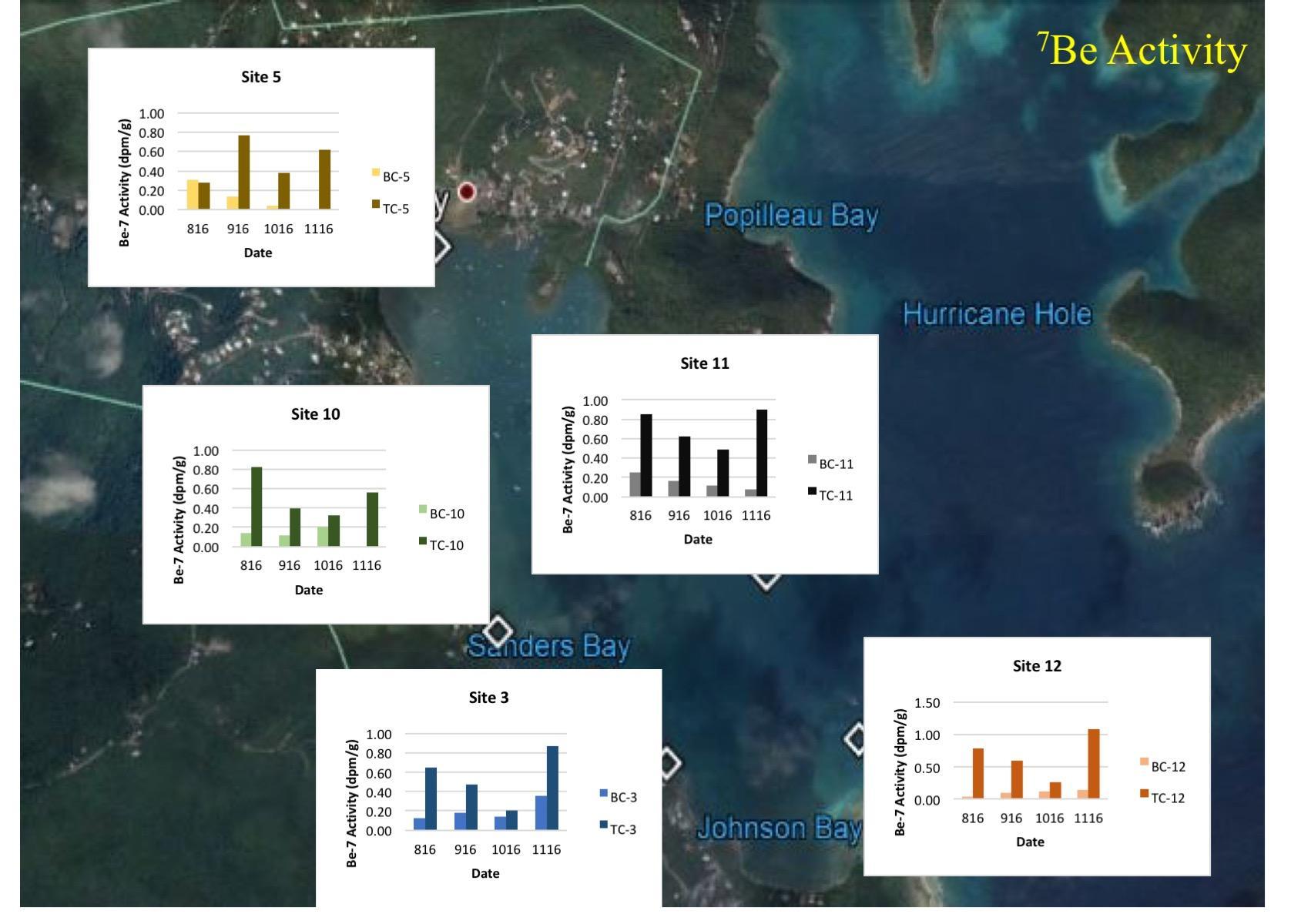
Figure 3 SLR data showing spatial (by site) and temporal (by sampling period, 8/16/16, 9/16/16, 10/16/16 and 11/16/16) variability in 7Be (t1/2=53 days) activity. Sediment trap samples are shown in dark colors (“TC”) and benthic sediments are shown in light colors (“BC”).
